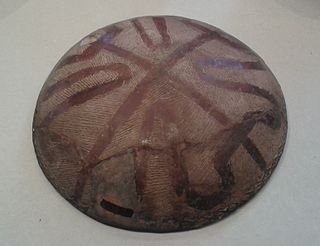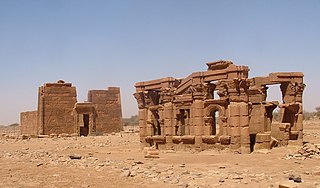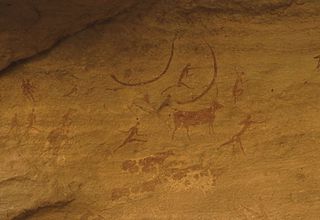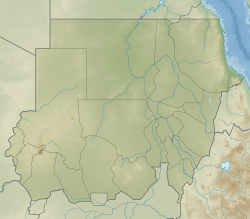The Nilotic peoples are people indigenous to the Nile Valley who speak Nilotic languages. They inhabit South Sudan, Sudan, Ethiopia, Uganda, Kenya, the Democratic Republic of the Congo, Rwanda, Burundi and Tanzania. Among these are the Burun-speaking peoples, Teso people also known as Iteso or people of Teso, Karo peoples, Luo peoples, Ateker peoples, Kalenjin peoples, Datooga, Dinka, Nuer, Atwot, Lotuko, and the Maa-speaking peoples.

The prehistory of North Africa spans the period of earliest human presence in the region to gradual onset of historicity in the Maghreb during classical antiquity. Early anatomically modern humans are known to have been present at Jebel Irhoud, in what is now Morocco, approximately 300,000 years ago. The Nile Valley region, via ancient Egypt, contributed to the Neolithic, Bronze Age and Iron Age periods of the Old World, along with the ancient Near East.

The C-Group culture is an archaeological culture found in Lower Nubia, which dates from c. 2400 BCE to c. 1550 BCE. It was named by George A. Reisner. With no central site and no written evidence about what these people called themselves, Reisner assigned the culture a letter. The C-Group arose after Reisner's A-Group and B-Group cultures, and around the time the Old Kingdom was ending in Ancient Egypt.

Nabta Playa was once a large endorheic basin in the Nubian Desert, located approximately 800 kilometers south of modern-day Cairo or about 100 kilometers west of Abu Simbel in southern Egypt, 22.51° north, 30.73° east. Today the region is characterized by numerous archaeological sites. The Nabta Playa archaeological site, one of the earliest of the Egyptian Neolithic Period, is dated to circa 7500 BC.
Uan Muhuggiag is an archaeological site in Libya that was occupied by pastoralists between the early Holocene and mid-Holocene; the Tashwinat mummy, which was found at Uan Muhuggiag, was dated to 5600 BP and presently resides in the Assaraya Alhamra Museum in Tripoli.
Hyrax Hill is a prehistoric site near Nakuru in the Rift Valley province of Kenya. It is a rocky spur roughly half a kilometer in length, with an elevation of 1,900 meters above sea level at its summit. The site was first discovered in 1926 by Louis Leakey during excavations at the nearby Nakuru Burial Site, and Mary Leakey conducted the first major excavations between 1937 and 1938. There are two distinct areas of occupation at Hyrax Hill: one which was occupied during the Pastoral Neolithic and late Iron Age, and one which was occupied by the Sirikwa earlier in the Iron Age.

Naqa or Naga'a is a ruined ancient city of the Kushitic Kingdom of Meroë in modern-day Sudan. The ancient city lies about 170 km (110 mi) north-east of Khartoum, and about 50 km (31 mi) east of the Nile River located at approximately MGRS 36QWC290629877. Here smaller wadis meet the Wadi Awateib coming from the center of the Butana plateau region, and further north at Wad ban Naqa from where it joins the Nile. Naqa was only a camel or donkey's journey from the Nile, and could serve as a trading station on the way to the east; thus it had strategic importance.

The Nile River is a major resource for the people living along it, especially thousands of years ago. The El Salha Archaeological Project discovered an abundance of evidence of an ancient boat that traveled the Nile River dating back to 3,000 years ago. Pictographs and pebble carvings were uncovered, indicating a boat more advanced than a simple canoe. This evidence of a progressed Nile boat includes a steering system which may have been used in the Nile for fishing and transportation.

The Savanna Pastoral Neolithic is a collection of ancient societies that appeared in the Rift Valley of East Africa and surrounding areas during a time period known as the Pastoral Neolithic. They were South Cushitic speaking pastoralists who tended to bury their dead in cairns, whilst their toolkit was characterized by stone bowls, pestles, grindstones and earthenware pots.

The Pastoral Neolithic refers to a period in Africa's prehistory, specifically Tanzania and Kenya, marking the beginning of food production, livestock domestication, and pottery use in the region following the Later Stone Age. The exact dates of this time period remain inexact, but early Pastoral Neolithic sites support the beginning of herding by 5000 BP. In contrast to the Neolithic in other parts of the world, which saw the development of farming societies, the first form of African food production was nomadic pastoralism, or ways of life centered on the herding and management of livestock. The shift from hunting to food production relied on livestock that had been domesticated outside of East Africa, especially North Africa. This period marks the emergence of the forms of pastoralism that are still present. The reliance on livestock herding marks the deviation from hunting-gathering but precedes major agricultural development. The exact movement tendencies of Neolithic pastoralists are not completely understood.
Ngamuriak is an archaeological site located in south-western Kenya. It has been interpreted as an Elmenteitan Pastoral Neolithic settlement. The excavation of this site produced pottery sherds, stone tools with obsidian fragments and obsidian blades, along with large amounts of animal bones.

The Elmenteitan culture was a prehistoric lithic industry and pottery tradition with a distinct pattern of land use, hunting and pastoralism that appeared and developed on the western plains of Kenya, East Africa during the Pastoral Neolithic c.3300-1200 BP. It was named by archaeologist Louis Leakey after Lake Elmenteita, a soda lake located in the Great Rift Valley, about 120 km (75 mi) northwest of Nairobi.

Jebel Moya is an archaeological site in the southern Gezira Plain, Sudan, approximately 250 km south southeast of Khartoum. Dating between 5000 BCE-500 CE and roughly 104,000 m2 in area, the site is one of the largest pastoralist cemeteries in Africa with over 3,000 burials excavated thus far. The site was first excavated by Sir Henry Wellcome from 1911 to 1914. Artifacts found at the site suggest trade routes between Jebel Moya and its surrounding areas, even as far as Egypt.
R12 is a middle Neolithic cemetery located in the Northern Dongola Reach on the banks of the Seleim Nile palaeochannel of modern-day Sudan. The site is dated to between 5000 and 4000 BC. Centro Veneto di Studi Classici e Orientali excavated the site, within the concession of the Sudan Archaeological Research Society and after an agreement with it, between 2000 and 2003 over three digging seasons. The first was in 2000 and 33 graves were discovered. The second was in 2001 and another 33 graves were discovered. The third was in 2003 and the last 100 graves were discovered. There are 166 graves total at the site. Contents of the graves include ceramics, animal bones, grinding stones, human skeletons, and plant remains.
Gebel Ramlah is a region in the Western Desert of southern Egypt that was occupied throughout the African Pastoral Neolithic. Archaeological research has focused primarily on individual burial sites and six pastoral cemeteries, including the earliest known infant cemetery in the world. The Gebel Ramlah cemeteries were active during the Final Neolithic in the fifth millennium BC. Ongoing excavation has uncovered over 200 human burials and elaborate grave goods. Research studies have been done on the pottery, mollusk shells, archaeobotanical remains, and skeletal remains found throughout the sites.
The Butana Group was a prehistoric, neolithic culture in the eastern part of modern Sudan, that flourished from the fourth to the early third millennium BC.

Pastoral rock art is the most common form of Central Saharan rock art, created in painted and engraved styles depicting pastoralists and bow-wielding hunters in scenes of animal husbandry, along with various animals, spanning from 6300 BCE to 700 BCE. The Pastoral Period is preceded by the Round Head Period and followed by the Caballine Period. The Early Pastoral Period spanned from 6300 BCE to 5400 BCE. Domesticated cattle were brought to the Central Sahara, and given the opportunity for becoming socially distinguished, to develop food surplus, as well as to acquire and aggregate wealth, led to the adoption of a cattle pastoral economy by some Central Saharan hunter-gatherers of the Late Acacus. In exchange, cultural information regarding utilization of vegetation in the Central Sahara was shared by Late Acacus hunter-gatherers with incoming Early Pastoral peoples.
Esh Shaheinab is an African archaeological site that was occupied multiple times during the early Holocene. Artifacts from this site exemplify various traditions including the Early Khartoum, Neolithic, and Late Neolithic.
Ghaba is a Neolithic cemetery mound and African archaeological site located in Central Sudan in the Shendi region of the Nile Valley. The site, discovered in 1977 by the Section Française de la Direction des Antiquités du Soudan (SFDAS) while they were investigating nearby Kadada, dates to 4750–4350 and 4000–3650 cal BC. Archaeology of the site originally heavily emphasized pottery, as there were many intact or mostly intact vessels. Recent analysis has focused on study of plant material found, which indicates that Ghaba may have been domesticating cereals earlier than previously believed. Though the site is a cemetery, little analysis has taken place on the skeletons due to circumstances of the excavation and poor preservation due to the environment. The artifacts at Ghaba suggest the people who used the cemetery were part of a regionalization separating central Sudan's Neolithic from Nubia. While many traditions match with Nubia, the people represented at Ghaba had some of their own particular practices in food production and bead and pottery production, which likely occurred on a relatively small scale. They also had some distinct funerary traditions, as evidenced by their grave goods. The people at Ghaba would have likely existed at least partially in a trade network that spread through the Nile and to the Red Sea. They used agriculture, cultivation, and cattle for sustenance.

The prehistory of East Africa spans from the earliest human presence in the region until the emergence of the Iron Age in East Africa. Between 1,600,000 BP and 1,500,000 BP, the Homo ergaster known as Nariokotome Boy resided near Nariokotome River, Kenya. Modern humans, who left behind remains, resided at Omo Kibish in 233,000 BP. Afro-Asiatic speakers and Nilo-Saharan speakers expanded in East Africa, resulting in transformation of food systems of East Africa. Prehistoric West Africans may have diverged into distinct ancestral groups of modern West Africans and Bantu-speaking peoples in Cameroon, and, subsequently, around 5000 BP, the Bantu-speaking peoples migrated into other parts of Sub-Saharan Africa.













